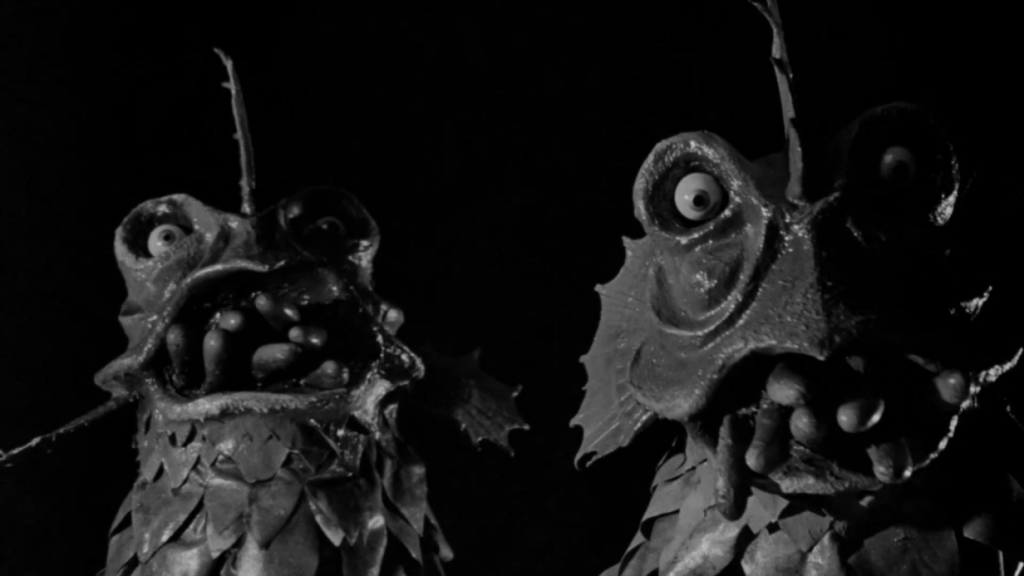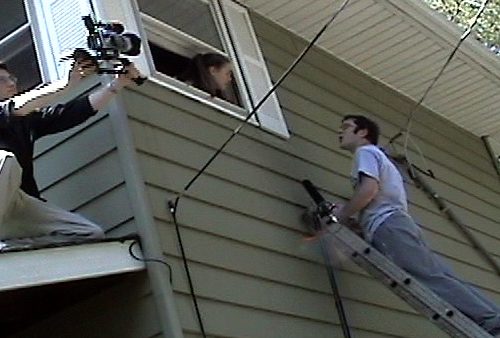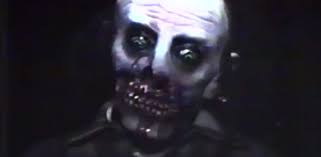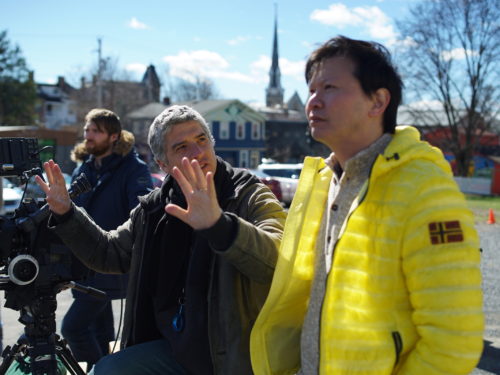Long blighted as the worst collection of sound and images ever captured on film, Del Tenney’s “horror-monster-musical” has quietly shifted the tide as a perfect time capsule of ’60s horror-comedy
“The film, described as ‘a take-off on beach parties and musicals,’ is considered to be one of the worst films of all time.” — Wikipedia
“By far the worst of the sixties beach films… The real horror of party beach is trying to sit through this mess!” — Thomas Lisanti, Hollywood Surf and Beach Movies: The First Wave, 1959-1969
“Boredom is abject and total.” — Raymond Durgnat, Films and Filming, 1964
The title says it all: The Horror of Party Beach. Atomic monsters that feed on human blood begin attacking a coastal Connecticut town where teenagers don’t want to stop the beach party, even if it’s hosted at the scene of a grisly crime. But even between brawls with biker gangs, surf-rock dance sequences, and deadly slumber parties, the film’s high-concept mixture of horror and beach party still somehow seems to be lost in translation. Party Beach has a reputation for being a monstrosity. It was famously shot by director Del Tenney and co. in two weeks on a $50,000 budget. It appeared in the book The Fifty Worst Films of All Time. Mystery Science Theater 3000 held nothing back in its scathing (though surprisingly dull) takedown of it (Ep. 817). Stephen King allegedly called it a wet fart of a film. Sure, Party Beach fits the bill perfectly for a MST3K episode: They used chocolate syrup for blood; The underwater scenes do nothing to disguise that the wrecked ship is a miniature toy with fish in an aquarium crudely superimposed on top; The monsters’ teeth are sausages. If you read this and expect a slickly produced action frightfest, reread the previous sentences and recalibrate your expectations.
Criticism leveled at the film can’t convincingly articulate why it’s one of the worst movies ever beyond snide jabs at its actors and its historical record as an object that exists to be laughed at. Its initial rollout may contribute to its reputation as a confused mess. Posters billed it as “the first horror monster musical,” two thirds of which could be debated. Many theatergoers in 1964 had to sign a “fright release” that relieved theaters of liability just in case the googly eyed monsters scared anyone to death. [Party Beach shared a double bill with The Curse of the Living Corpse, also directed by Tenney. Neither are likely to inflict mortal terror.] For a high-concept horror film, the clues of what Party Beach is about are as basic as can be, but the pace at which it slips between beach, party, and horror is unrelenting, which could also explain the disconnect between intent and reception. Like many “so bad it’s good” films, reviewers seem to latch onto production errors or bogus science, then jump to labeling it as a terrible film with little justification beyond the fact that it’s hokey. But even its harshest critics seem to concede that the film has an unshakable joy to it.
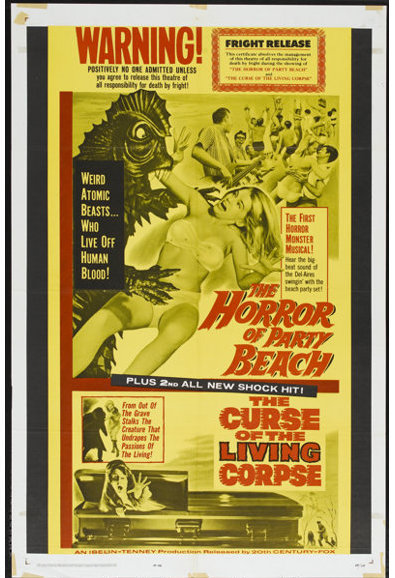
The opening minutes introduce us to an overcast beach town in summer where biker gangs and teenagers rule the streets and the sand. It’s a confounding, rapid-paced world that we’re immersed in through the eyes of Hank Green (John Scott), the stereotypical all-American, blond-haired ladies man and prodigal scientist-in-training. He drives a slick convertible, and on the way to the beach his car is flanked by the bikers (played by the Charter Oak Motorcycle Club of Samford, Connecticut, a real biker gang with loose affiliations to the Hell’s Angels) while his girlfriend Tina (Marilyn Clark) makes eyes at them and swigs whiskey from the bottle in the passenger seat. Tina dumps him almost as soon as they arrive at the beach, citing her own experiments that she needs to conduct outside the confines of Hank’s laboratories. She drops to her knees dancing in the sand when she sees the lead biker watching her. Hank tries to win her back by brawling with the bikers. Strangers jump to his defense — and I mean they literally flip and have choreographed jump kicks off of one another’s chests — before Hank and the gang leader coolly shake hands post-fight. Tina runs to the water and swims to a quiet inlet.
Out on the water, a small boat carrying barrels of nuclear waste seeks its drop site. At the seafloor lies a recently wrecked ship. The skeletal remains of the crew are doused by a leaky barrel of said nuclear waste, and in seconds a shipwrecked sailor is resurrected as a zombified sea monster. The transformation sequence develops slowly, with each transition to black showing a more developed skull. Crustaceans sprout from the ear holes, fins protrude in front, perfectly circular eyes emerge. It’s a brilliant sequence that harnesses the essence of the film: it’s cheap, endearing, and it produces an unforgettable monster.
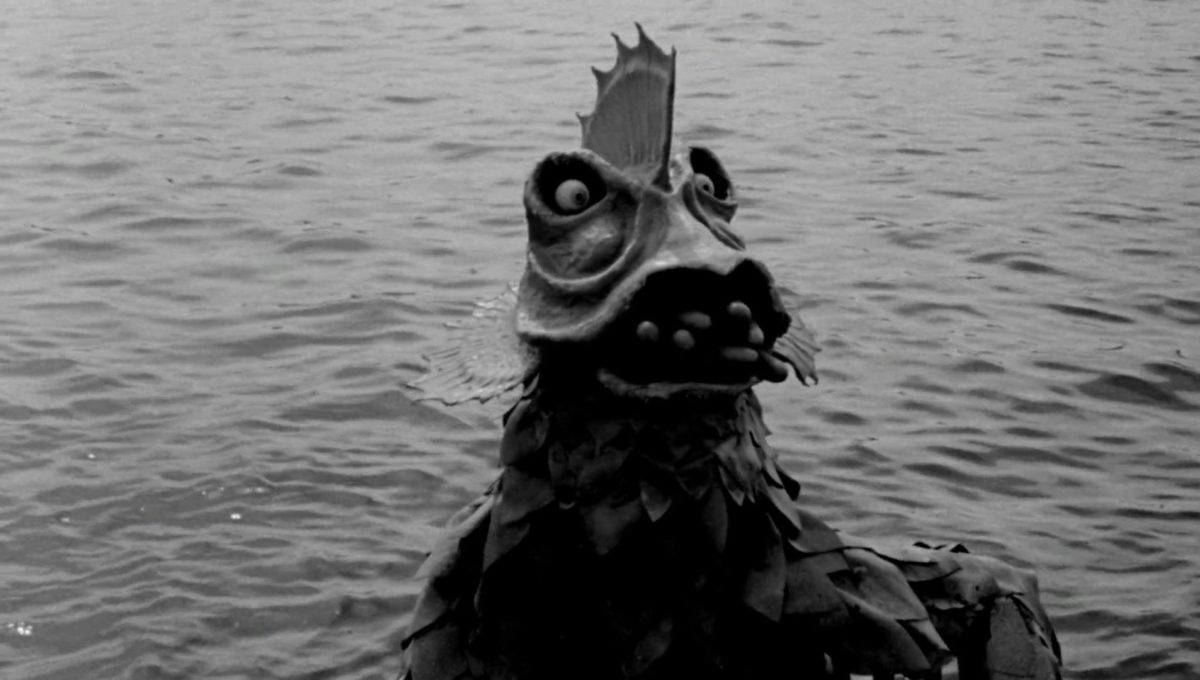
Out of water and fully formed, the monster is unnaturally lanky, its head propped high above its shoulders as it stalks across the rocks. Its call blurts like a distorted bullfrog with a permanently unhinged lower jaw, the soundtrack striking a dissonant harmony. The monster zeroes in on Tina sitting alone and pounces from behind. The attack is more vicious than expected as it smears puddled blood across her stomach and shakes her by the neck. It leaves her face down in the water and swims away. The police reject suspicions that the killer emerged from the water, but they consult Dr. Gavin, Hank’s professor, to run tests on a tissue sample left on Tina’s body. A fruitless search begins.
The film’s most brutal attack arrives at a sorority slumber party. The girls sing campfire songs about women being slaves to their husbands and indulge in an obligatory pillow fight. They’re hoping and expecting that a few fraternity boys will drop by and prank them. They decide to turn the tables and booby trap the doors with water buckets balanced on top for a counterprank of their own. When they hear plodding footsteps outside, the giggles are irrepressible; the fun is about to begin. Instead of a strapping fraternity brother, a horde of monsters ambush the party and kill all 11 women there (though the news reports the tally at over 20. Roll with it). Instead of an innocent gag, the spilled water bucket is simply another spill to clean up alongside the blood shed on the floors.
As the monsters and murders proliferate and spread through town, the film tries to stay safe enough for a general ’60s audience on the verge of Beatlemania, despite turning every new character into a target. Almost without exception, any time a new character appears as the star of a scene it means they are the next to die. Tina is the only character to be dispatched who we have any form of preexisting attachment to. Tenney doesn’t kill off the stars one-by-one as would later become the norm in slasher films. This emotional distance keeps us from being personally invested in the characters as they are introduced and eliminated, from a group of roadtrippers to local stumbling drunks. The nameless victims serve an important function: They minimize useless side scene diversions to give the monsters as much screen time as possible. Think of how many boring monster movies would take us into the classroom to show Hank being a star pupil, only to establish a minor character who would later be killed. That’s a useless six minutes avoided. Instead, the film becomes a showcase for the goofy and multiplying monsters. The monsters are the stars, and no serious lull exists between sightings. The pacing is lightning quick and the benefits of concision far outweigh the emotional connections that could have been.
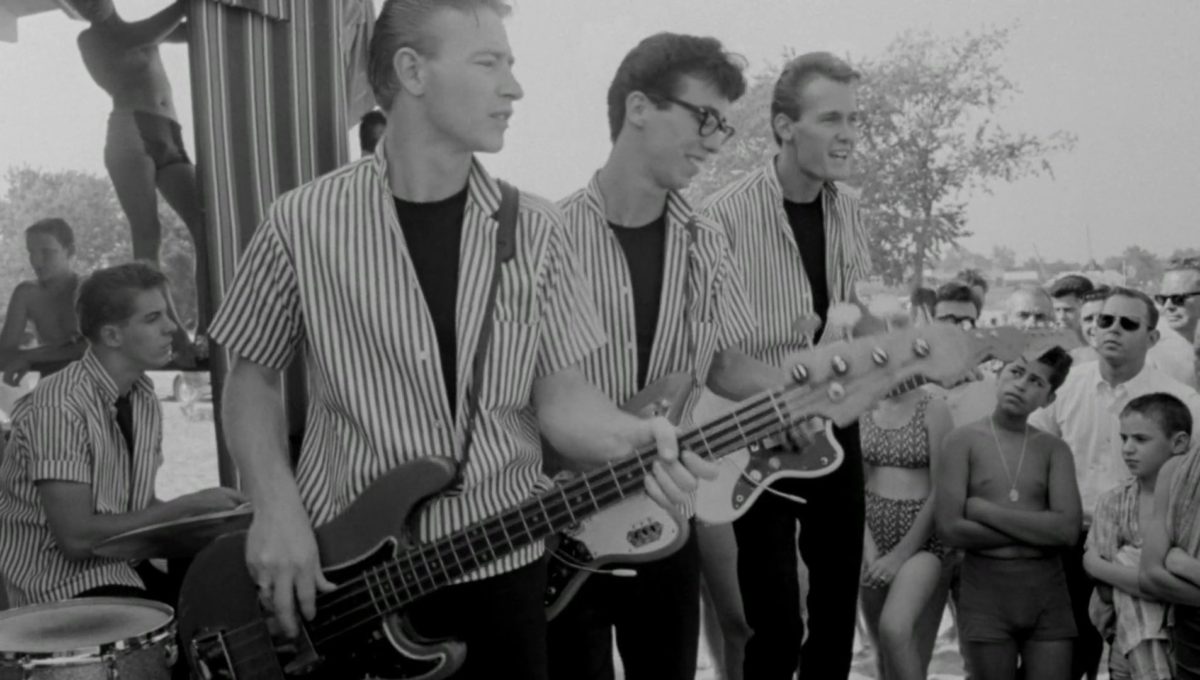
One frequent complaint leveled at the film is that The Del-Aires, the beach’s house band, are a boring and unnecessary addition. The Del-Aires may as well have stepped out a vintage Fender advertisement with their Jaguar guitars, Jazz Basses, and matching striped outfits. They serenade the beachgoers through slow dances, fights, and “The Zombie Stomp” alike with practiced smiles and swoons. The Del-Aires’ pinstripe shirts are ripe for teasing and match their twee mannerisms, but their job is to simply keep the party going. In the nighttime dance scene following Tina’s death, only a few teen couples are out. The dance floor is empty, the band sitting off to the side on break. The atmosphere hints that everyone knows they should be home. But they show up anyway, simply out of habit. The dance floor is only yards away from the first site of an ongoing murder spree. But they still arrive and try to enact standard summer nights. When Elaine (Alice Lyon), Hank’s new girlfriend and daughter of Dr. Gavin, requests “You Are Not A Summer Love,” the kids start to slow dance and, at least for a moment, Party Beach is the shelter from the storm — even if they’re knowingly dancing in the storm’s eye.
Related: Satan’s Pilgrims: Three Decades Of Sinister Surf by Cooper Green
The New York Times’ initial review couldn’t comprehend this state of mind: “The most curious aspect of both films [Tenney’s Curse of the Living Corpse being the other] is why, after the first couple of homicides, the rest of the victims linger around the disaster area, waiting for the worst. Audiences lured into the theater may ask themselves the same thing.” This scene embodies everything essential about horror movies. Everyone there knows about the imminent dangers that await. They know their friends and neighbors have been killed. But they seek temporary relief over the safety of staying home behind locked doors. As long as others are partying, why shouldn’t I? More importantly, they live out the teen dilemma: What else should I be doing? The Del-Aires are the source of the film’s most carefree moments early on, which makes this communal display of carelessness and confusion a more powerful scene than it has any right to be.
I will concede that the film’s worst offense is its path to victory. After Eulabelle (Eulabelle Moore), the Gavins’ maid, who has long suspected voodoo is afoot, accidentally spills elemental sodium on a severed monster arm in the lab, Dr. Gavin and the police plot to eradicate the saltwater monsters by pelting them with sodium. (Ignore the science.) Eulabelle encourages Hank to keep calling stores until he’s found enough sodium to stop the invasion. After almost quitting, he finally reserves a batch in New York City. How often is a good monster ultimately defeated by someone combing through the phone book?
A brief detour as an Americana road flick threatens to upend the conclusion, but redemption arrives in the final showdown. The police embark on a frantic search to locate the monsters’ lair by testing the waters for radiation emitted by the creatures. Instead, Elaine — alone and armed with only a geiger counter — discovers their hideaway in the waters of Fingle’s quarry. In her haste to escape, she slips and pins her leg between two rocks as monsters emerge from the deepest waters in town. Hank, Dr. Gavin, and the police race to the quarry and begin the sodium assault on the encroaching beasts. The monsters are birthed with the cheapest and most endearing practical effects, and their departures are equally magnificent. These monsters don’t die bloody deaths when pelted with sodium — they poof and evaporate into Méliès-style clouds, sausage teeth and all.
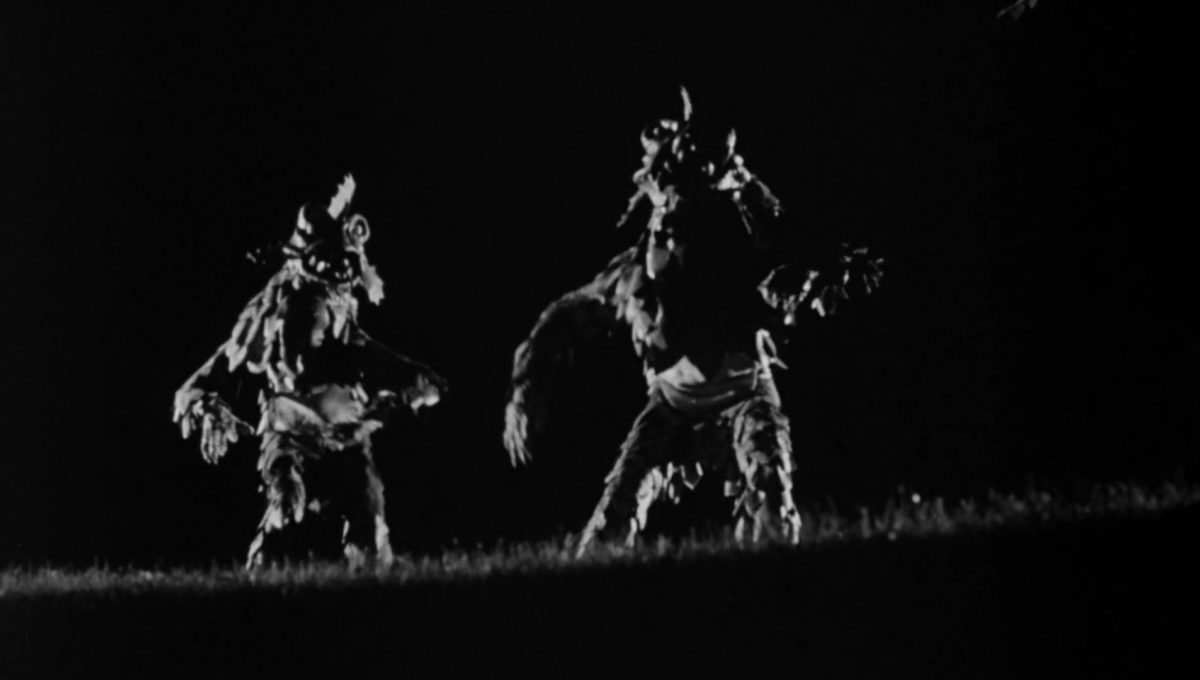
The film is counterintuitive in the sense that its strengths are its weaknesses — the cheap monsters should be horror icons — and its weaknesses are what make it a memorable film all these years later. Does a better time-capsule exist for what horror-comedy looked like in the mid-’60s? It was made for drive-ins, in the disposable sense of the term, but unlike the binge-and-purge catalog Netflix and the stream teams shove up our noses these days, The Horror of Party Beach found an everlasting home as an emblem of a bygone era. What Mystery Science Theater and all the snarky takedowns miss is the fact that this is what a movie created outside Hollywood and entirely for the fun of it should look like. Sure, all of the science is bogus. Yeah, the beach (which is actually a bay) is overcast. The climax takes place at a quarry, not the titular beach. The local actors aren’t supermodels. Many complaints harp on the women not being hot enough for Hollywood, the men not sufficiently chiseled. This was Del Tenney’s hometown. To say the people aren’t beautiful enough while calling the casting unrealistic for a beach film is such a backwards complaint. The humor can be offputting if you’re expecting a sex-craved beach flick, like when a teen asks his friend if they remembered hot dog buns while ogling a woman shaking her ass. Hollywood may preach that all that teenage boys think about is sex, but The Horror of Party Beach is the rare films that knows its sex and food the teenagers crave. This is not a film made by a team of accountants with crystal-ball algorithms. It’s a film made by humans with entertainment on a budget in mind.
The Horror of Party Beach certainly has its defenders. It received a pristine 2K Blu-ray restoration from Severin Films in 2018 with bonus documentaries about the film’s creation and legacy. For every negative review, there’s a blog buried deep on Google that praises the film. But even the glowing reviews are usually from websites praising the worst films ever made. In essence, it has become a poster child for the “so bad it’s good” wave that suggests the film is best enjoyed with an armful of choice beverages and a condescending mind. The more horror films I watch, the more the “so bad it’s good” trope emboldens itself as the greatest unshakable lie sold to horror fans. Many of my favorite horror films look and sound like they were made by children — In some cases they were. Horror films are the rare sandbox where filmmakers can shape the world to their vision and forgo the established rules of respectable Hollywood, no matter the budget. They’re best judged and enjoyed on the merit of their creativity, not their coherence. The Horror of Party Beach was made cheap and fast with practicality in mind. For every flaw this film has, it also has a ridiculously strong highlight reel of what a horror-monster-musical made in small-town ’60s Connecticut can be. For every viewer who cannot take anything about this film seriously is another with a look of pure joy on their face, who cannot pry their eyes away from the screen for all of its 78 minutes. After all, a castle made of sand is still a castle, even if it’s made of the sands of Party Beach.
Find the complete October Horror 2021 series here:
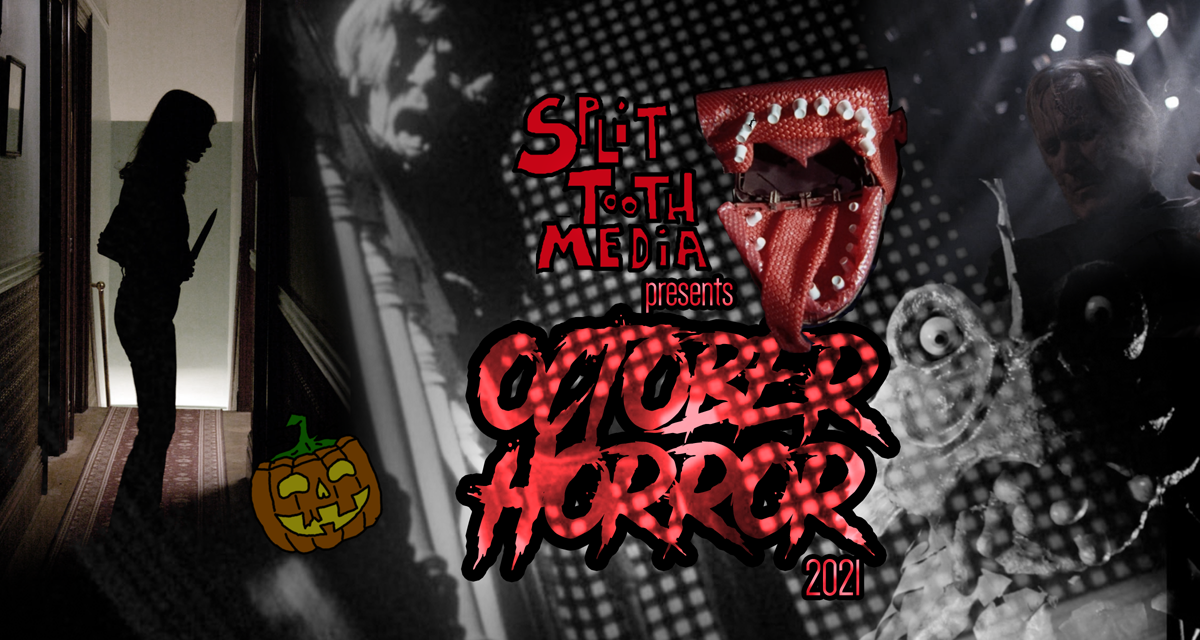
Find The Horror of Party Beach on your preferred streaming service through JustWatch
Purchase The Horror of Party Beach on Blu-ray from Severin Films
Stay up to date with all things Split Tooth Media and follow Craig on Twitter
(Split Tooth may earn a commission from purchases made through affiliate links on our site.)

